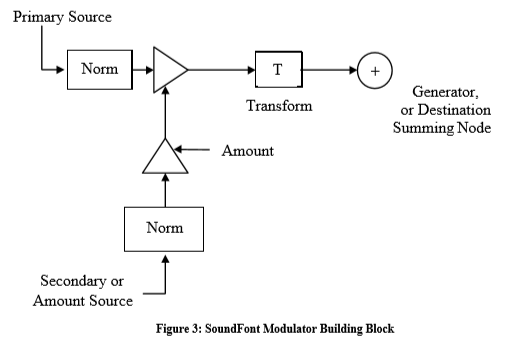More from SoundFont specifications:
"A modulator is defined by its sfModSrcOper, its sfModDestOper, and its sfModSrcAmtOper. All modulators within a zone must have a unique set of these three enumerators. If a second modulator is encountered with the same three enumerators as a previous modulator with the same zone, the first modulator will be ignored." sfModSrcOper contains the specification for the primary source and the primary "Norm" curve. SfModDestOper is equal to the SoundFont generator to be modified. sfModSrcAmtOper contains the specification for the secondary source and the secondary "Norm" curve. This means that you cannot have two modulators in the chain with the same destination, source, primary "Norm" curve and secondary source and secondary "Norm" curve. You can change the Amount and the transform value, which is "0" or linear by default. (It is up to the synthesizer engineer to construct other transforms, so don't rely on it!)
You can have as many modulators in a chain as you like and all of them could modify the same generator, provided that sfModSrcOper, sfModDestOper, and sfModSrcAmtOper are not the same.
NOTE; All possible sources are "real time" in nature, except for two "in-built" ones: Velocity and Key#. These two are specified once and for all in the MIDI note event and cannot change after a note has started. However, there are numerous other ways to change the note loudness or pitch in real time.
There are 10 so called "default" modulators:
1. MIDI Note-On Velocity to Initial Attenuation - you are probably used to thinking that the lower the note velocity the lower will the note volume become. This is true only if this default modulator is in effect, which it mostly is. But it can be switched off or even turned around.
2. MIDI Note-On Velocity to Filter Cutoff - this modulator will make the low pass filter cutoff frequency lower at lower velocities, which is mostly a natural behavior. For example: if the cutoff frequency, initialFilterFc, is set to 20000Hz (no cutoff) then it will become 14900Hz for a note of velocity 100 and 7739Hz at velocity 40. NOTE: this modulator makes it totally unnecessary to define velocity splits with different cutoff frequencies for an instrument when the audio data is sampled at only one velocity.
3. MIDI Channel Pressure to Vibrato LFO Pitch Depth - use this modulator to change the value of the generator vibLFOtoPitch.
4. MIDI Continuous Controller 1 to Vibrato LFO Pitch Depth - use this modulator to change the value of the generator vibLFOtoPitch.
5. MIDI Continuous Controller 7 to Initial Attenuation - CC#7 is usually called "Volume (coarse)" and the expected behavior is to influence the overall output level of the sound.
6. MIDI Continuous Controller 10 to Pan Position - CC#10 is usually called "pan (coarse)" and the expected behavior is to influence the spatial position of a note in the stereophonic field.This is again an expected behavior.
7. MIDI Continuous Controller 11 to Initial Attenuation - CC#11 is usually called "Expression (coarse)" and the expected behavior is to influence the overall output level of the sound.
8. MIDI Continuous Controller 91 to Reverb Effects Send - SynthFont makes use of VST effects, so this modulator is not implemented.
9. MIDI Continuous Controller 93to Chorus Effects Send - SynthFont makes use of VST effects, so this modulator is not implemented.
10. MIDI Pitch Wheel to Initial Pitch Controlled by MIDI Pitch Wheel Sensitivity - the standard behavior is to change the pitch down or up in a liner fashion so that a maximum is two semitones swing in either direction, but all of this can be changed in many ways. For example, listen to these three notes:
More about the default modulators from the SoundFont specifications:
"These modulator values are the default for the instrument level; IE they are not default at the preset level. The default modulators at the preset level are such that there is no additional control over any parameter. “Default” modulators are also refered to as “General MIDI” modulators because their settings and values match the MIDI specification.
Note that these modulators are implicit to the file format, so in order to turn them off one must explicitly put modulators in the appropriate level of the hierarchy to either supersede or negate the effect of these modulators."
Restrictions
From the SoundFont specification: "CC index values 0, 6, 32, 38, 98 through 101, and 120 through 127 are ILLEGAL due to their nature as a MIDI functions rather than true MIDI controllers. Also, index values 33 through 63 should be reserved for LSB contributions of controller indices 1 through 31. If these index values are encountered, the entire modulator structure should be ignored." Additionally, SynthFont2 and it's siblings ignore modulators for some other CC:s as well: 5 (Portamento Time), 7 (Volume), 8 (Balance) ,10 (pan), 11 (Expression), 65 (Portamento On/Off Switch) and 84 (Portamento CC Control) as these have a very specific meaning in many MIDI files.


